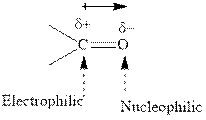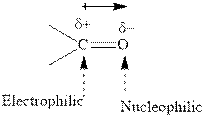
(a)
Interpretation:The product formed in indicated reaction should be formulated and whether it is chiral and shows any optical activity or not should be determined.

Concept introduction: The carbonyl bond is polar with partial positive charge on carbon and partial negative charge on oxygen as illustrated below.

Thus it can undergo hydride addition at carbon and proton addition at oxygen. Certain reagents that are useful for such hydride addition at carbonyl carbon include
Optical activity refers to ability to rotate the plane polarized light. For example, if the light is passed through a substance and the light that emerges has radiations are confined to one plane only the substance is said to be optically active.
The earliest criteria for optical activity were presence of a chiral center. The chiral refer to species attached to four different substituents. Chiral center leads to existence of organic compounds as two enantiomeric forms. However chiral center alone is not sufficient condition for determination of optical activity.
The criteria to identify the optical activity are to look for absence of any symmetry element. The symmetry elements make any molecule optically inactive.
(b)
Interpretation: The product formed in indicated reaction should be formulated and whether it is chiral and shows any optical activity or not should be determined.

Concept introduction: The carbonyl bond is polar with partial positive charge on carbon and partial negative charge on oxygen as illustrated below.

Thus it can undergo hydride addition at carbon and proton addition at oxygen. Certain reagents that are useful for such hydride addition at carbonyl carbon include
Optical activity refers to ability to rotate the plane polarized light. For example, if the light is passed through a substance and the light that emerges has radiations are confined to one plane only the substance is said to be optically active.
The earliest criteria for optical activity were presence of a chiral center. The chiral refer to species attached to four different substituents. Chiral center leads to exists of organic compounds as two enantiomeric forms. However chiral center alone is not sufficient condition for determination of optical activity.
The criteria to identify the optical activity are to look for absence of any symmetry element. The symmetry elements make any molecule optically inactive.
(c)
Interpretation: The product formed in indicated reaction should be formulated and whether it is chiral and shows any optical activity or not should be determined.

Concept introduction:The carbonyl bond is polar with partial positive charge on carbon and partial negative charge on oxygen as illustrated below.

Thus it can undergo hydride addition at carbon and proton addition at oxygen. Certain reagents that are useful for such hydride addition at carbonyl carbon include
Optical activity refers to ability to rotate the plane polarized light. For example, if the light is passed through a substance and the light that emerges has radiations are confined to one plane only the substance is said to be optically active.
The earliest criteria for optical activity were presence of a chiral center. The chiral refer to species attached to four different substituents. Chiral center leads to exists of organic compounds as two enantiomeric forms. However chiral center alone is not sufficient condition for determination of optical activity.
The criteria to identify the optical activity are to look for absence of any symmetry element. The symmetry elements make any molecule optically inactive.
(d)
Interpretation: The product formed in indicated reaction should be formulated and whether it is chiral and shows any optical activity or not should be determined.

Concept introduction:The carbonyl bond is polar with partial positive charge on carbon and partial negative charge on oxygen as illustrated below.

Thus it can undergo hydride addition at carbon and proton addition at oxygen. Certain reagents that are useful for such hydride addition at carbonyl carbon include
Optical activity refers to ability to rotate the plane polarized light. For example, if the light is passed through a substance and the light that emerges has radiations are confined to one plane only the substance is said to be optically active.
The earliest criteria for optical activity were presence of a chiral center. The chiral refer to species attached to four different substituents. Chiral center leads to exists of organic compounds as two enantiomeric forms. However chiral center alone is not sufficient condition for determination of optical activity.
The criteria to identify the optical activity are to look for absence of any symmetry element. The symmetry elements make any molecule optically inactive.
Want to see the full answer?
Check out a sample textbook solution
Chapter 8 Solutions
ORGANIC CHEMISTRY (LL)-PACKAGE
- Beer’s Law is A = εbc, where A is absorbance, ε is the molar absorptivity (which is specific to the compound and wavelength in the measurement), and c is concentration. The absorbance of a 2.31 × 10-5 M solution of a compound is 0.822 at a wavelength of 266 nm in a 1.00-cm cell. Calculate the molar absorptivity at 266 nm.arrow_forwardHow to calculate % of unknown solution using line of best fit y=0.1227x + 0.0292 (y=2.244)arrow_forwardGiven a 1,3-dicarbonyl compound, state the (condensed) formula of the compound obtaineda) if I add hydroxylamine (NH2OH) to give an isooxazole.b) if I add thiosemicarbazide (NH2-CO-NH-NH2) to give an isothiazole.arrow_forward
- Complete the following acid-base reactions and predict the direction of equilibrium for each. Justify your prediction by citing pK values for the acid and conjugate acid in each equilibrium. (a) (b) NHs (c) O₂N NH NH OH H₁PO₁arrow_forward23.34 Show how to convert each starting material into isobutylamine in good yield. ཅ ནད ཀྱི (b) Br OEt (c) (d) (e) (f) Harrow_forwardPlease help me Please use https://app.molview.com/ to draw this. I tried, but I couldn't figure out how to do it.arrow_forward
- Propose a synthesis of 1-butanamine from the following: (a) a chloroalkane of three carbons (b) a chloroalkane of four carbonsarrow_forwardSelect the stronger base from each pair of compounds. (a) H₂CNH₂ or EtzN (b) CI or NH2 NH2 (c) .Q or EtzN (d) or (e) N or (f) H or Harrow_forward4. Provide a clear arrow-pushing mechanism for each of the following reactions. Do not skip proton transfers, do not combine steps, and make sure your arrows are clear enough to be interpreted without ambiguity. a. 2. 1. LDA 3. H3O+ HOarrow_forward
- b. H3C CH3 H3O+ ✓ H OHarrow_forward2. Provide reagents/conditions to accomplish the following syntheses. More than one step is required in some cases. a. CH3arrow_forwardIdentify and provide an explanation that distinguishes a qualitative and quantitative chemical analysis. Provide examples.arrow_forward
 Chemistry: The Molecular ScienceChemistryISBN:9781285199047Author:John W. Moore, Conrad L. StanitskiPublisher:Cengage Learning
Chemistry: The Molecular ScienceChemistryISBN:9781285199047Author:John W. Moore, Conrad L. StanitskiPublisher:Cengage Learning Organic ChemistryChemistryISBN:9781305580350Author:William H. Brown, Brent L. Iverson, Eric Anslyn, Christopher S. FootePublisher:Cengage Learning
Organic ChemistryChemistryISBN:9781305580350Author:William H. Brown, Brent L. Iverson, Eric Anslyn, Christopher S. FootePublisher:Cengage Learning Chemistry & Chemical ReactivityChemistryISBN:9781337399074Author:John C. Kotz, Paul M. Treichel, John Townsend, David TreichelPublisher:Cengage Learning
Chemistry & Chemical ReactivityChemistryISBN:9781337399074Author:John C. Kotz, Paul M. Treichel, John Townsend, David TreichelPublisher:Cengage Learning
 Chemistry & Chemical ReactivityChemistryISBN:9781133949640Author:John C. Kotz, Paul M. Treichel, John Townsend, David TreichelPublisher:Cengage Learning
Chemistry & Chemical ReactivityChemistryISBN:9781133949640Author:John C. Kotz, Paul M. Treichel, John Townsend, David TreichelPublisher:Cengage Learning




